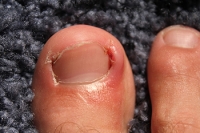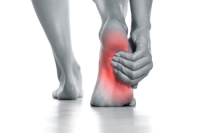
Blog (826)
Common Sources of Foot Pain

Foot pain often develops due to injury, structural issues, or medical conditions that affect the bones, joints, and soft tissues of the feet. Common sources of foot pain include bunions, heel spurs, flat feet, and plantar fasciitis. These conditions can place strain on the arch, heel, or forefoot and lead to discomfort with walking or standing. Nerve problems, such as Morton’s neuroma and peripheral neuropathy, may cause burning, tingling, or numbness, especially in the toes or ball of the foot. Pain can also result from arthritis, which may affect the joints of the toes and ankles, or from deformities, like hammertoe, that are caused by a muscle imbalance. Repeated stress, poor foot mechanics, and trauma can lead to stress fractures, tendon injuries, or ligament sprains. A podiatrist can evaluate your symptoms, examine foot alignment and mobility, and use imaging tests to confirm a diagnosis. If you have foot pain, it is suggested that you schedule an appointment with a podiatrist for an exam and appropriate treatment options.
Foot Pain
Foot pain can be extremely painful and debilitating. If you have a foot pain, consult with Dr. Kenneth Donovan from Advanced Care Foot and Ankle. Our doctor will assess your condition and provide you with quality foot and ankle treatment.
Causes
Foot pain is a very broad condition that could be caused by one or more ailments. The most common include:
- Bunions
- Hammertoes
- Plantar Fasciitis
- Bone Spurs
- Corns
- Tarsal Tunnel Syndrome
- Ingrown Toenails
- Arthritis (such as Gout, Rheumatoid, and Osteoarthritis)
- Flat Feet
- Injury (from stress fractures, broken toe, foot, ankle, Achilles tendon ruptures, and sprains)
- And more
Diagnosis
To figure out the cause of foot pain, podiatrists utilize several different methods. This can range from simple visual inspections and sensation tests to X-rays and MRI scans. Prior medical history, family medical history, and any recent physical traumatic events will all be taken into consideration for a proper diagnosis.
Treatment
Treatment depends upon the cause of the foot pain. Whether it is resting, staying off the foot, or having surgery; podiatrists have a number of treatment options available for foot pain.
If you have any questions, please feel free to contact one of our offices located in Warren, Livingston, and Toms River, NJ . We offer the newest diagnostic and treatment technologies for all your foot care needs.
Understanding Metatarsal Joint Pain

The metatarsals are the five long bones in the middle of the foot that connect the toes to the rest of the foot structure. These bones play a key role in weight bearing and movement, especially during walking, running, or standing for long periods. Metatarsal joint pain can occur when there is inflammation or strain in the area where these bones meet the toes. This pain is often described as a burning, aching, or sharp sensation in the ball of the foot and may worsen with activity. Causes can include overuse, wearing improper footwear, foot deformities, or arthritis. Rest, footwear changes, and padding can provide relief. Custom orthotics are sometimes recommended to improve alignment and reduce pressure on the joints. If pain in the ball of your foot is making it hard to stay active, it is suggested that you consult a podiatrist for an accurate diagnosis and effective treatment.
Arthritis can be a difficult condition to live with. If you are seeking treatment, contact Dr. Kenneth Donovan from Advanced Care Foot and Ankle. Our doctor can provide the care you need to keep you pain-free and on your feet.
Arthritic Foot Care
Arthritis is a term that is commonly used to describe joint pain. The condition itself can occur to anyone of any age, race, or gender, and there are over 100 types of it. Nevertheless, arthritis is more commonly found in women compared to men, and it is also more prevalent in those who are overweight. The causes of arthritis vary depending on which type of arthritis you have. Osteoarthritis for example, is often caused by injury, while rheumatoid arthritis is caused by a misdirected immune system.
Symptoms
- Swelling
- Pain
- Stiffness
- Decreased Range of Motion
Arthritic symptoms range in severity, and they may come and go. Some symptoms stay the same for several years but could potentially get worse with time. Severe cases of arthritis can prevent its sufferers from performing daily activities and make walking difficult.
Risk Factors
- Occupation – Occupations requiring repetitive knee movements have been linked to osteoarthritis
- Obesity – Excess weight can contribute to osteoarthritis development
- Infection – Microbial agents can infect the joints and trigger arthritis
- Joint Injuries – Damage to joints may lead to osteoarthritis
- Age – Risk increases with age
- Gender –Most types are more common in women
- Genetics – Arthritis can be hereditary
If you suspect your arthritis is affecting your feet, it is crucial that you see a podiatrist immediately. Your doctor will be able to address your specific case and help you decide which treatment method is best for you.
If you have any questions, please feel free to contact one of our offices located in Warren, Livingston, and Toms River, NJ . We offer the newest diagnostic and treatment technologies for all your foot care needs.
It's Time for Beautiful Feet
Foot Exercises Can Help Prevent Falls

As people age, their feet often lose strength and mobility, which can affect balance and increase the risk of falls. Stiff joints, weaker foot muscles, and reduced ankle flexibility can make walking less stable, especially on uneven surfaces. A podiatrist may recommend exercises that focus on improving the function of the feet, toes, and ankles. Strengthening the small muscles in the feet and increasing ankle mobility can enhance balance and coordination. Exercises such as calf raises, toe lifts, and towel curls can help improve the ability of the feet to respond to sudden shifts in weight. Controlled movement in the ankles also helps with walking and changing direction safely. By improving how the foot and ankle work together, these exercises support better posture and movement. A podiatrist can assess your foot structure and recommend an exercise plan to help prevent falls by addressing weakness, joint stiffness, or other underlying conditions. If you have balance issues that put you at risk for falls, or have injured your feet from falling, it is suggested that you schedule an appointment with a podiatrist who can treat various foot conditions, and offer helpful guidance.
Preventing falls among the elderly is very important. If you are older and have fallen or fear that you are prone to falling, consult with Dr. Kenneth Donovan from Advanced Care Foot and Ankle. Our doctor will assess your condition and provide you with quality advice and care.
Every 11 seconds, an elderly American is being treated in an emergency room for a fall related injury. Falls are the leading cause of head and hip injuries for those 65 and older. Due to decreases in strength, balance, senses, and lack of awareness, elderly persons are very susceptible to falling. Thankfully, there are a number of things older persons can do to prevent falls.
How to Prevent Falls
Some effective methods that older persons can do to prevent falls include:
- Enrolling in strength and balance exercise program to increase balance and strength
- Periodically having your sight and hearing checked
- Discuss any medications you have with a doctor to see if it increases the risk of falling
- Clearing the house of falling hazards and installing devices like grab bars and railings
- Utilizing a walker or cane
- Wearing shoes that provide good support and cushioning
- Talking to family members about falling and increasing awareness
Falling can be a traumatic and embarrassing experience for elderly persons; this can make them less willing to leave the house, and less willing to talk to someone about their fears of falling. Doing such things, however, will increase the likelihood of tripping or losing one’s balance. Knowing the causes of falling and how to prevent them is the best way to mitigate the risk of serious injury.
If you have any questions, please feel free to contact one of our offices located in Warren, Livingston, and Toms River, NJ . We offer the newest diagnostic and treatment technologies for all your foot care needs.
Plantar Warts in Children

Plantar warts are common in children and are caused by the human papillomavirus, or HPV, which thrives in warm, moist environments like public swimming pool areas, locker rooms, and public shower areas. The virus enters the skin through tiny cuts or abrasions on the soles of the feet. Symptoms include small, rough growths on the bottom of the feet, usually on weight-bearing areas like the heels or balls of the feet. These warts may cause pain or tenderness when walking or standing, often feeling like a pebble stuck in the shoe. A podiatrist can help diagnose and treat plantar warts with various methods, including topical treatments and cryotherapy, which involves freezing the wart, for more stubborn cases. It is important to treat warts early to prevent them from spreading. To prevent plantar warts, children should wear protective footwear in public areas and avoid sharing shoes or socks. Keeping feet clean and dry also helps reduce the risk. If your child is dealing with this condition, it is suggested that you schedule an appointment to see a podiatrist.
Plantar warts can be very uncomfortable. If you need your feet checked, contact Dr. Kenneth Donovan from Advanced Care Foot and Ankle. Our doctor will assist you with all of your foot and ankle needs.
About Plantar Warts
Plantar warts are the result of HPV, or human papillomavirus, getting into open wounds on the feet. They are mostly found on the heels or balls of the feet.
While plantar warts are generally harmless, those experiencing excessive pain or those suffering from diabetes or a compromised immune system require immediate medical care. Plantar warts are easily diagnosed, usually through scraping off a bit of rough skin or by getting a biopsy.
Symptoms
- Lesions on the bottom of your feet, usually rough and grainy
- Hard or thick callused spots
- Wart seeds, which are small clotted blood vessels that look like little black spots
- Pain, discomfort, or tenderness of your feet when walking or standing
Treatment
- Freezing
- Electric tool removal
- Laser Treatment
- Topical Creams (prescription only)
- Over-the-counter medications
To help prevent developing plantar warts, avoid walking barefoot over abrasive surfaces that can cause cuts or wounds for HPV to get into. Avoiding direct contact with other warts, as well as not picking or rubbing existing warts, can help prevent the further spread of plantar warts. However, if you think you have developed plantar warts, speak to your podiatrist. He or she can diagnose the warts on your feet and recommend the appropriate treatment options.
If you have any questions please feel free to contact one of our offices located in Warren, Livingston, and Toms River, NJ . We offer the newest diagnostic and treatment technologies for all your foot and ankle needs.
Effective Foot Stretches

Keeping the feet flexible and strong is essential for overall mobility and balance. One simple method is practicing toe stretches by gently pulling the toes upward and downward to loosen tight muscles. Improving toe flexibility further enhances foot strength and reduces the risk of injury. A foot massage stretch, where you knead and press into the soles, helps to release tension and promote blood flow. Using a tennis ball to stretch the plantar fascia is another effective technique. This is done by rolling the ball under the foot as it targets deep tissue, which eases discomfort. Additionally, walking barefoot on safe, natural surfaces like grass or sand encourages the feet to move naturally, strengthening muscles and improving balance. If foot pain arises, it is suggested that you contact a podiatrist who can treat various foot conditions, and guide you on effective foot stretches.
Stretching the feet is a great way to prevent injuries. If you have any concerns with your feet consult with Dr. Kenneth Donovan from Advanced Care Foot and Ankle. Our doctor will assess your condition and provide you with quality foot and ankle treatment.
Stretching the Feet
Being the backbone of the body, the feet carry your entire weight and can easily become overexerted, causing cramps and pain. As with any body part, stretching your feet can serve many benefits. From increasing flexibility to even providing some pain relief, be sure to give your feet a stretch from time to time. This is especially important for athletes or anyone performing aerobic exercises, but anyone experiencing foot pain or is on their feet constantly should also engage in this practice.
Great ways to stretch your feet:
- Crossing one leg over the others and carefully pull your toes back. Do 10-20 repetitions and repeat the process for each foot
- Face a wall with your arms out and hands flat against the wall. Step back with one foot and keep it flat on the floor while moving the other leg forward. Lean towards the wall until you feel a stretch. Hold for 30 seconds and perform 10 repetitions for each foot
- Be sure not to overextend or push your limbs too hard or you could risk pulling or straining your muscle
Individuals who tend to their feet by regular stretching every day should be able to minimize foot pain and prevent new problems from arising.
If you have any questions, please feel free to contact one of our offices located in Warren, Livingston, and Toms River, NJ . We offer the newest diagnostic and treatment technologies for all your foot care needs.
Heel Pain Can Be Treated!
Treating Problematic Ingrown Toenails
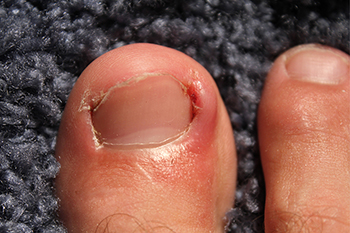
When ingrown toenails do not respond to basic care or become painful and infected, a podiatrist can provide effective medical treatment. In less severe cases, the ingrown section of the toenail can be carefully removed during a minor procedure called partial nail avulsion, which reduces pressure and allows the area to heal. For patients with recurring ingrown toenails, a podiatrist may recommend a matrixectomy, a surgical technique that removes the nail root in the affected area to prevent regrowth. If infection is present, antibiotics may also be prescribed to reduce swelling and stop the spread of bacteria. In some situations, total nail removal may be required, particularly when the toenail is deeply curved or repeatedly causes pain. Such ingrown toenail procedures are typically performed using local anesthesia to ensure patient comfort. After surgery, patients are advised to keep the area clean and dry and avoid wearing tight footwear to support healing. If you have problematic ingrown toenails, it is suggested that you schedule an appointment with a podiatrist for a diagnosis and appropriate treatment.
Ingrown toenails can become painful if they are not treated properly. For more information about ingrown toenails, contact Dr. Kenneth Donovan of Advanced Care Foot and Ankle. Our doctor can provide the care you need to keep you pain-free and on your feet.
Ingrown Toenails
Ingrown toenails occur when a toenail grows sideways into the bed of the nail, causing pain, swelling, and possibly infection.
Causes
- Bacterial infections
- Improper nail cutting such as cutting it too short or not straight across
- Trauma to the toe, such as stubbing, which causes the nail to grow back irregularly
- Ill-fitting shoes that bunch the toes too close together
- Genetic predisposition
Prevention
Because ingrown toenails are not something found outside of shoe-wearing cultures, going barefoot as often as possible will decrease the likeliness of developing ingrown toenails. Wearing proper fitting shoes and using proper cutting techniques will also help decrease your risk of developing ingrown toenails.
Treatment
Ingrown toenails are a very treatable foot condition. In minor cases, soaking the affected area in salt or antibacterial soaps will not only help with the ingrown nail itself, but also help prevent any infections from occurring. In more severe cases, surgery is an option. In either case, speaking to your podiatrist about this condition will help you get a better understanding of specific treatment options that are right for you.
If you have any questions please feel free to contact one of our offices located in Warren, Livingston, and Toms River, NJ . We offer the newest diagnostic and treatment technologies for all your foot and ankle needs.
Causes of Foot and Ankle Pain in Teens
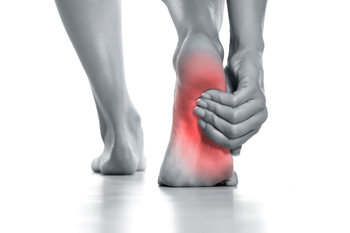
Foot and ankle pain in teens can result from a variety of causes, often related to growth, physical activity, or underlying conditions. Active teens may experience pain due to overuse injuries from sports or exercise, including stress fractures, tendonitis, or sprains. Growth spurts can lead to conditions like Sever’s disease, where the heel’s growth plate becomes irritated. Wearing improper footwear or lack of support can contribute to arch pain or heel discomfort. Flat feet, high arches, or biomechanical imbalances may also cause strain on joints and soft tissues. In some cases, pain may stem from inflammatory conditions or infections. If your teenager has foot pain, it is suggested that you schedule an appointment with a podiatrist who can determine what the cause is, and offer appropriate treatment solutions.
Foot Pain
Foot pain can be extremely painful and debilitating. If you have a foot pain, consult with Dr. Kenneth Donovan from Advanced Care Foot and Ankle. Our doctor will assess your condition and provide you with quality foot and ankle treatment.
Causes
Foot pain is a very broad condition that could be caused by one or more ailments. The most common include:
- Bunions
- Hammertoes
- Plantar Fasciitis
- Bone Spurs
- Corns
- Tarsal Tunnel Syndrome
- Ingrown Toenails
- Arthritis (such as Gout, Rheumatoid, and Osteoarthritis)
- Flat Feet
- Injury (from stress fractures, broken toe, foot, ankle, Achilles tendon ruptures, and sprains)
- And more
Diagnosis
To figure out the cause of foot pain, podiatrists utilize several different methods. This can range from simple visual inspections and sensation tests to X-rays and MRI scans. Prior medical history, family medical history, and any recent physical traumatic events will all be taken into consideration for a proper diagnosis.
Treatment
Treatment depends upon the cause of the foot pain. Whether it is resting, staying off the foot, or having surgery; podiatrists have a number of treatment options available for foot pain.
If you have any questions, please feel free to contact one of our offices located in Warren, Livingston, and Toms River, NJ . We offer the newest diagnostic and treatment technologies for all your foot care needs.
That Ankle Pain May Be Caused by Gout
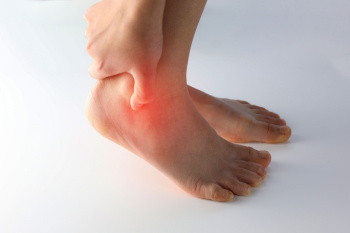
Gout is a painful type of arthritis that can affect the ankle, not just the big toe. It develops when uric acid builds up in the body and forms sharp crystals in the joints. When this occurs in the ankle, it may cause sudden, sharp pain along with swelling, redness, and warmth in the area. Movements like walking or climbing stairs can become difficult during a flare-up. Gout flare-ups in the ankle may last for several days and often return over time, if not properly managed. Risk factors include a diet high in red or organ meats, alcohol consumption, sugary beverages, excess body weight, and high blood pressure. A podiatrist can help determine whether gout is the cause of your ankle pain by examining the foot and ordering diagnostic tests, including bloodwork or imaging. Once diagnosed, a podiatrist can recommend treatment that may include medication to lower uric acid levels and reduce inflammation. If you are experiencing sharp pain in your ankles, it is suggested that you schedule an appointment with a podiatrist for an exam to determine if gout is the cause.
Gout is a painful condition that can be treated. If you are seeking treatment, contact Dr. Kenneth Donovan from Advanced Care Foot and Ankle. Our doctor will treat your foot and ankle needs.
What Is Gout?
Gout is a form of arthritis that is characterized by sudden, severe attacks of pain, redness, and tenderness in the joints. The condition usually affects the joint at the base of the big toe. A gout attack can occur at any random time, such as the middle of the night while you are asleep.
Symptoms
- Intense Joint Pain - Usually around the large joint of your big toe, and it most severe within the first four to twelve hours
- Lingering Discomfort - Joint discomfort may last from a few days to a few weeks
- Inflammation and Redness -Affected joints may become swollen, tender, warm and red
- Limited Range of Motion - May experience a decrease in joint mobility
Risk Factors
- Genetics - If family members have gout, you’re more likely to have it
- Medications - Diuretic medications can raise uric acid levels
- Gender/Age - Gout is more common in men until the age of 60. It is believed that estrogen protects women until that point
- Diet - Eating red meat and shellfish increases your risk
- Alcohol - Having more than two alcoholic drinks per day increases your risk
- Obesity - Obese people are at a higher risk for gout
Prior to visiting your podiatrist to receive treatment for gout, there are a few things you should do beforehand. If you have gout you should write down your symptoms--including when they started and how often you experience them, important medical information you may have, and any questions you may have. Writing down these three things will help your podiatrist in assessing your specific situation so that he or she may provide the best route of treatment for you.
If you have any questions, please feel free to contact one of our offices located in Warren, Livingston, and Toms River, NJ . We offer the newest diagnostic and treatment technologies for all your foot care needs.









